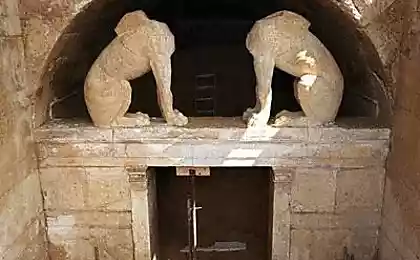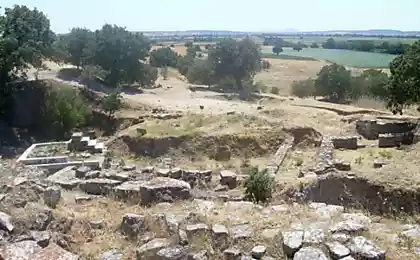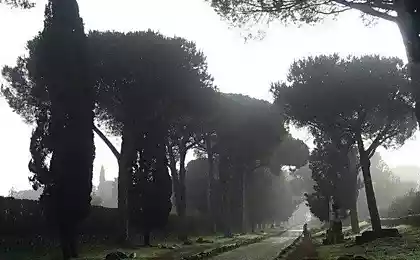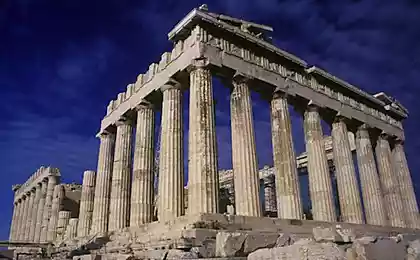428
The tomb in Amphipolis was younger than Alexander the great
Archaeologist Katerina Peristeri (Peristeri Katerina), which directs the excavations of the tomb at Kasta hill in Amphipolis (Greece), has denied rumors that it might be the tomb of Alexander the great. According to her, the tomb is dated to the last quarter of the IV century BC and, most likely, was built after the death of the commander.
"I think that by Christmas, if not sooner, we will have news," promised the archeologist.
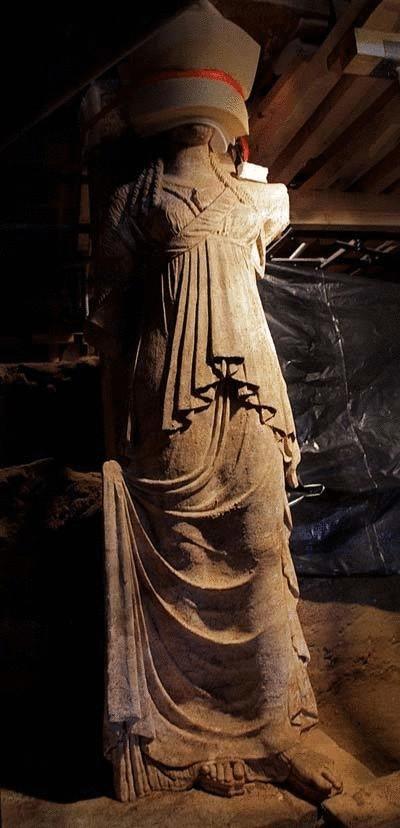
The Caryatid from the tomb in Amphipolis.
Earlier, the Ministry of culture of Greece has published pictures of the caryatids guarding the entrance to the third room of the tomb. Their height is about 2.30 meters. Caryatids carved out of marble brought from the island of Thasos. They have traces of blue and red paint. Sculptures stand between two marble pillars supporting a beam of the ceiling.
Caryatids dressed in tunics, they have earrings. The girls have long, thick hair covering the shoulders. The face of one of the caryatids is preserved almost in its original form, the second is lost. Pieces of the palms and fingers of fragments of sculpture were recovered from the soil that filled the chamber. Feet girls sandals with thick soles, which in Ancient Greece was called buskins (kothornoi). On the shoes had traces of red and yellow paint.
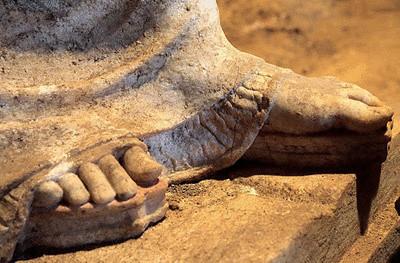
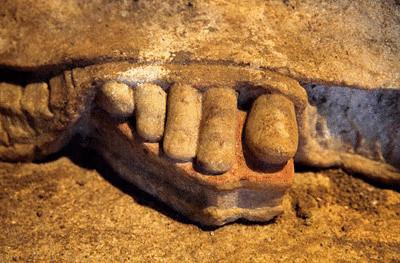
Sandals caryatids.
"The right arm of the Western Caryatid and the left arm of the East stretched, as if they symbolically warn against any attempt to enter the burial place", according to the Ministry of culture of Greece.
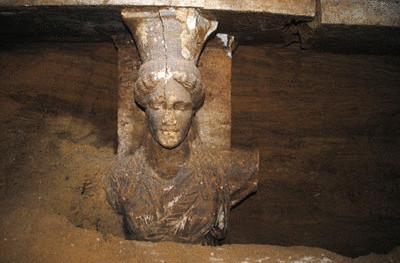
The upper part of the caryatids in the process of excavation.
Greek media, citing sources in the Ministry of culture of Greece reported that the tomb can be fourth room. Details about what is the basis of this assumption, yet. Now archaeologists are clearing a third camera.
The tomb is located 104 kilometers East of Thessaloniki. It is surrounded by an imposing wall, the perimeter of which is about 490 meters. Originally the mound was a statue of a lion, a height of about 5 meters. Now she moved to a nearby road.
In August, archaeologists have discovered two partially destroyed the statue of the Sphinx, who "guarded" the entrance to the burial complex. The sphinxes were about 1.5 meters in height. The weight of each – about 1.5 tons. The heads and wings of creatures lost.
In the tomb are open mosaic floors. They consisted of irregular pieces of white marble laid on a red background.
Archaeologists tight-lipped about who could find rest in the tomb. It is possible that it was built by Deinocrates (Dinocrates), the chief architect of Alexander the great. Some experts not involved in the excavation, suggesting that it could be buried one of the companions of the commander or one of his relatives.
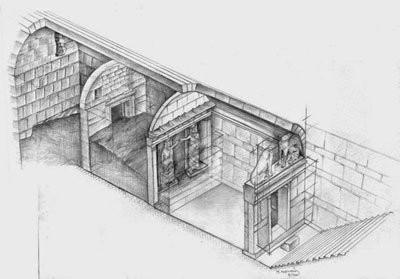
Graphic reconstruction of the tomb.
Source: nkj.ru
"I think that by Christmas, if not sooner, we will have news," promised the archeologist.

The Caryatid from the tomb in Amphipolis.
Earlier, the Ministry of culture of Greece has published pictures of the caryatids guarding the entrance to the third room of the tomb. Their height is about 2.30 meters. Caryatids carved out of marble brought from the island of Thasos. They have traces of blue and red paint. Sculptures stand between two marble pillars supporting a beam of the ceiling.
Caryatids dressed in tunics, they have earrings. The girls have long, thick hair covering the shoulders. The face of one of the caryatids is preserved almost in its original form, the second is lost. Pieces of the palms and fingers of fragments of sculpture were recovered from the soil that filled the chamber. Feet girls sandals with thick soles, which in Ancient Greece was called buskins (kothornoi). On the shoes had traces of red and yellow paint.


Sandals caryatids.
"The right arm of the Western Caryatid and the left arm of the East stretched, as if they symbolically warn against any attempt to enter the burial place", according to the Ministry of culture of Greece.

The upper part of the caryatids in the process of excavation.
Greek media, citing sources in the Ministry of culture of Greece reported that the tomb can be fourth room. Details about what is the basis of this assumption, yet. Now archaeologists are clearing a third camera.
The tomb is located 104 kilometers East of Thessaloniki. It is surrounded by an imposing wall, the perimeter of which is about 490 meters. Originally the mound was a statue of a lion, a height of about 5 meters. Now she moved to a nearby road.
In August, archaeologists have discovered two partially destroyed the statue of the Sphinx, who "guarded" the entrance to the burial complex. The sphinxes were about 1.5 meters in height. The weight of each – about 1.5 tons. The heads and wings of creatures lost.
In the tomb are open mosaic floors. They consisted of irregular pieces of white marble laid on a red background.
Archaeologists tight-lipped about who could find rest in the tomb. It is possible that it was built by Deinocrates (Dinocrates), the chief architect of Alexander the great. Some experts not involved in the excavation, suggesting that it could be buried one of the companions of the commander or one of his relatives.

Graphic reconstruction of the tomb.
Source: nkj.ru
